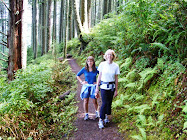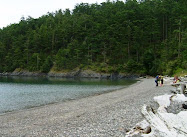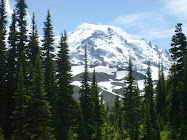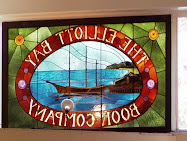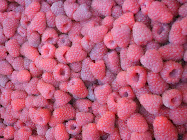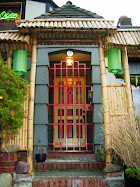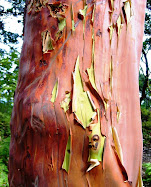 |
| The "diamond ring" emerging from totality. Photo by Allen Denver. |
In today's hyper-speed news cycles, the 2017 total eclipse that sliced across the USA on August 21 is old news. But in the days since, I've been replaying that amazing 1 minute and 48 seconds in my mind, lingering over the too-brief spectacle.
It was the most thrilling, mind-bending, magnificent natural event I've ever experienced.
The bonus? It capped a wonderful weekend on a family farm in the Willamette Valley filled with happy, interesting people, great food, and kick-back fun. Life doesn't get much better.
Over 40 people and 7 dogs converged on the farm situated conveniently in the path of totality. We ranged in age from 6 to almost 80. Many of us pitched tents in the orchard, some slept in RVs and campers, while others lodged in the barn.
As people arrived over several days from Seattle, Portland, and even Santa Cruz, California, it was fun to meet old friends and make new ones. As Tonia said, it was like "a family reunion with the people you like even though some of us had never met."
Some went hiking and exploring in this beautiful, pastoral patch of the valley near Silverton, and some stayed close to relax, cook, or read. Several kids picked fat, sun-ripened blackberries for pie, which hostess extraordinaire Mary Lou helped them make.
 |
| The taste of late summer in the Pacific Northwest. |
Although there was a possibility of clouds, I awoke before sunrise on Monday morning and peeked out of my tent to see sweet clear skies. As fast as possible, I threw on a fleece sweater and jeans, grabbed my cameras, and ran out in the morning quiet to shoot the sunrise, my favorite time of day.
 | ||||||||
| Eclipse day sunrise - minus 4 hours. |
After another hearty breakfast of farm fresh bacon, eggs, fruit, pancakes, and more, the anticipation edged up several notches. We spread out in a couple open fields and patches with good views to the east, set up chairs and cameras, got out our eclipse glasses, and watched as the moon slowly crept across the sun in tiny but increasingly large increments.
 |
| Sheet spread out to catch the post-eclipse wave shadows. |
As the moon encroached more over the sun, the light was unlike anything I've seen, as if someone turned down the dimmer switch in the sky.
Shortly before totality the roosters started crowing, and I heard what sounded like an owl hooting from the patch of woods behind the field. A short hush fell while the last sliver of light faded from view, as if everyone held an intake of breath for an extra second.
When I could no longer see any light at all through the eclipse glasses, I tore them off.
That first stunning glimpse of a big black circle in the black sky, surrounded by the white glow of the sun's corona shimmering outward in delicate filaments of light, will forever be seared in my mind.
(For you art history types, it reminded me a bit of the dramatic crown of thorns in Grunewald's famous Eisenheim alterpiece, only more exquisitely gossamer.)
All the photos I've seen don't quite capture it. But they're close.
 |
| Totality. Photo by Allen Denver. |
I'd heard people say to look around, so I did. In this instant predawn/dusk, there was a tinge of red on the horizon in every direction.
Then I grabbed my camera and snapped some shots, put the camera down, put on my regular sunglasses and gazed up at that wondrous sight above again. I remember thinking, if this was a few thousand years ago and I didn't know what caused this, it would be a fearsome sight indeed.
Far too soon totality was over. I wanted more.
Some of us drove away quickly to try and beat traffic (no such luck) and some people stayed another night at the farm. I waited until after dinner and headed north at 6 pm. After 8 long hours on the road without a break, I pulled up to my home in Seattle at 2 a.m.
Of course I want to see another total eclipse now. Next time I wouldn't try to take any photos and would instead focus more on the sun and surrounding sky during totality, without sunglasses. I'd heard conflicting things about the safety of viewing without any protective lenses during totality (consensus: it's safe). As a result, I missed seeing the stars in the background around the sun.
So how about you? Did you make it to the totality zone and see this spectacular phenomenon? If so, how did you react or feel? Would love to hear about your experience in a comment below.
And perhaps Chile in 2019?
 |
| Photo by Allen Denver. |
Happy trails and thanks for visiting Pacific Northwest Seasons! In between blog posts, visit Pacific NW Seasons on FaceBook, Twitter, and Instagram for more Northwest photos and outdoors news.
Thanks to Allen Denver for letting me use some of his great eclipse photos. And extra special thanks to our generous and gracious hosts Mary Lou and Ben.



























